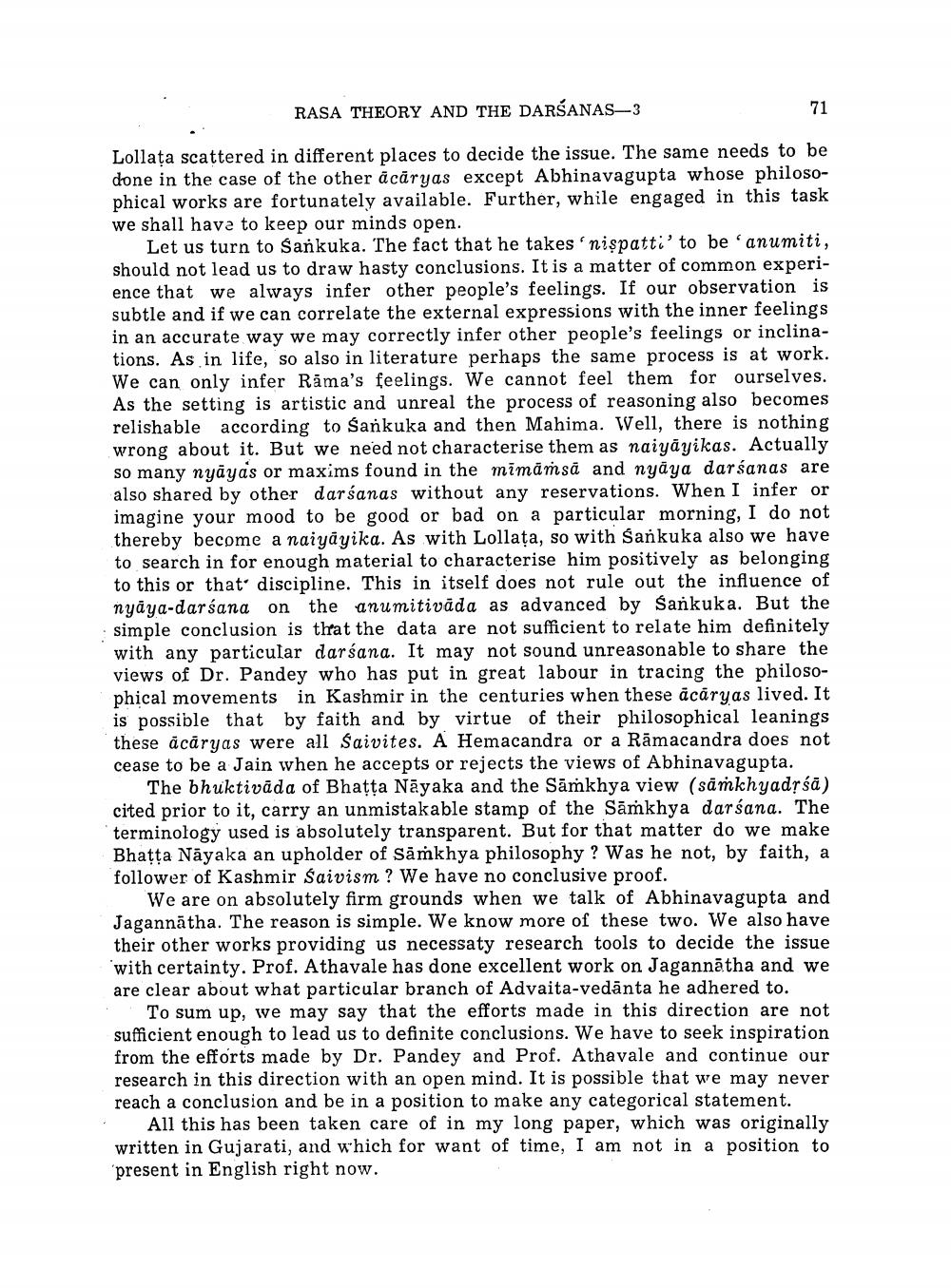________________
RASA THEORY AND THE DARŠANAS-3
Lollața scattered in different places to decide the issue. The same needs to be done in the case of the other acāryas except Abhinavagupta whose philosophical works are fortunately available. Further, while engaged in this task we shall have to keep our minds open.
Let us turn to Sankuka. The fact that he takes' nispatti' to be 'anumiti, should not lead us to draw hasty conclusions. It is a matter of common experience that we always infer other people's feelings. If our observation is subtle and if we can correlate the external expressions with the inner feelings in an accurate way we may correctly infer other people's feelings or inclinations. As in life, so also in literature perhaps the same process is at work. We can only infer Rāma's feelings. We cannot feel them for ourselves. As the setting is artistic and unreal the process of reasoning also becomes relishable according to Sankuka and then Mahima. Well, there is nothing wrong about it. But we need not characterise them as naiyāyikas. Actually so many nyāyas or maxims found in the mimārsā and nyāya darśanas are also shared by other darśanas without any reservations. When I infer or imagine your mood to be good or bad on a particular morning, I do not thereby become a naiyāyika. As with Lollata, so with Sankuka also we have to search in for enough material to characterise him positively as belonging to this or that discipline. This in itself does not rule out the influence of nyāya-darśana on the anumitivāda as advanced by Sankuka. But the simple conclusion is that the data are not sufficient to relate him definitely with any particular darśana. It may not sound unreasonable to share the views of Dr. Pandey who has put in great labour in tracing the philosophical movements in Kashmir in the centuries when these acāryas lived. It is possible that by faith and by virtue of their philosophical leanings these acāryas were all Saivites. A Hemacandra or a Rāmacandra does not cease to be a Jain when he accepts or rejects the views of Abhinavagupta.
The bhuktivāda of Bhatta Nāyaka and the Sāmkhya view (sarkhyad?śā) cited prior to it, carry an unmistakable stamp of the Sāmkhya darśana. The terminology used is absolutely transparent. But for that matter do we make Bhatta Nāyaka an upholder of Samkhya philosophy ? Was he not, by faith, a follower of Kashmir Saivism ? We have no conclusive proof.
We are on absolutely firm grounds when we talk of Abhinavagupta and Jagannatha. The reason is simple. We know more of these two. We also have their other works providing us necessaty research tools to decide the issue with certainty. Prof. Athavale has done excellent work on Jagannātha and we are clear about what particular branch of Advaita-vedānta he adhered to.
To sum up, we may say that the efforts made in this direction are not sufficient enough to lead us to definite conclusions. We have to seek inspiration from the efforts made by Dr. Pandey and Prof. Athavale and continue our research in this direction with an open mind. It is possible that we may never reach a conclusion and be in a position to make any categorical statement.
All this has been taken care of in my long paper, which was originally written in Gujarati, and which for want of time, I am not in a position to present in English right now.




